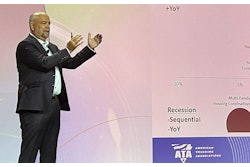Jim Angel (left) was recruited by Harold Krane (right), vice president of logistics for Atrium Companies, to become the company’s director of fleet transportation. Angel previously was employed by one of Atrium Companies’ third-party logistics providers.
In January 2005, Harold Krane, vice president of logistics for Atrium Companies, faced a critical deadline. In three months, Atrium – one of the largest manufacturers of vinyl and aluminum windows in the United States – would need about 60 trucks to service one of its largest traffic lanes.
Atrium Companies oversees logistics operations for 22 manufacturing and distribution facilities across the country. It assists in services such as developing packaging, monitoring the cubing of freight and the routing of runs, selecting carriers, selecting and maintaining equipment, and weekly reporting and monitoring of each facility’s delivery operations to provide visibility and accountability for management. It also operates some equipment under Atrium Transportation Group, which manages DOT safety regulations, fuel control and other transportation management functions.
Atrium’s two largest manufacturing areas, Dallas-Fort Worth and North Carolina, were using third-party transportation providers or “3PLs” for the usual reasons, Krane says. In the Dallas-Fort Worth area, Atrium’s contract with its third-party provider was to expire on April 23, 2005. The vendor announced that it would require a significant rate increase to renew its contract.
In late 2004, Krane requested bids through an RFP that covered the delivery from four plants in the Dallas-Fort Worth area to Atrium’s customers nationwide. To assist in managing the RFP process, Atrium Companies hired consultant Paul Gold, president of Atlanta-based Transportation Consultants Inc., to add his 40 years of experience to Krane’s 40-plus.
“Going into a long-term contract, we wanted to have another set of experienced eyes,” Krane says.
Bids came in from November 2004 through late January 2005. The lowest bid would have increased cost by $800,000 annually – with uncertainty in the area of service improvement, particularly from a new provider.
“As the bids came in, we decided to include ourselves as a bidder,” Krane says. “We had our model for costing, and we had the infrastructure. We chose to cover our exposure for maintenance through a contract maintenance program. Our present insurance carrier would indemnify our casualty exposure, and we felt that we had the experience and the expertise to control the operating costs.”
For Atrium’s board of directors, the conservative estimate of 2005 cost savings of $650,000 (not including fluctuations in fuel), along with proposed service benefits for operating the private fleet, were enough for their decision: Krane received the go-ahead to launch the private fleet in late January.
Going private
To ensure a smooth transition after the April 23 cutoff, one of Krane’s first actions was to hire Jim Angel. Krane and Angel had worked together in the 1990s and had launched several “start-up” logistical projects. Additionally, Angel had three years’ experience as fleet manager for the Atrium account. Angel worked for Atrium’s third-party transportation provider from 2000 until 2003.
“He called me on January 25,” Angel says. “He had already ordered trucks.”
To launch a 60-truck private fleet by April 23, the two developed a “punch list” that included cutoff dates and backup plans for critical tasks such as hiring drivers and office staff, purchasing supplies, implementing technology such as onboard computing and equipment tracking, and setting up fuel performance programs.
“All of the action items had target dates color-coded to denote degree of urgency,” says Angel, now Atrium’s director of fleet transportation. “It was a process that went extremely well.”
One of the first efforts in the transition was to recruit drivers who had been working for Atrium as employees of the 3PL. Most of those drivers had worked for the Atrium account since 2000 and, as such, were experienced with handling and identifying Atrium’s product. Additionally, they were familiar with the customers and what it took to keep them happy, Angel says, adding that some of those drivers had been working for Atrium before the 3PL was awarded the contract in 2000.
Recruiting this group was management’s first objective; but they also created a backup plan with at least two other options to fill the staffing need for drivers – just in case.
“We felt we had to be aggressive in our financial package offering, and in providing a desirable working environment,” Angel says. Atrium increased individual driver pay by about $5,000 a year. The top-tier drivers by seniority received an 8 to 10 percent increase. The entire compensation package and benefits were reviewed and improved. Angel also increased the beginning rate for drivers from 30 to 33 cents per mile. As a result, most of the drivers on the 3PL’s payroll made the transition.
When drivers crossed over on April 23, they were handed keys to new tractors – which arrived only 10 days before the cutoff date. The trucks were equipped with Sirius satellite radios and refrigerators, among other comfort items. These increases were in line with the numbers budgeted. “Drivers were extremely pleased,” Angel says.
The startup went with no interruption in service.
Tracking improvements
To benchmark the cost savings, Angel uses the same invoice and spreadsheet he created while managing the Atrium account for his previous employer. “We decided to monitor our actual ’05 performance versus what the low 3PL bidder would have charged,” Angel says.
The delta between actual expenses and Atrium Transportation Group’s “billing” to the facilities using the third-party delivery rate is credited back to each division, pro-rata; the difference is related to the individual facility’s utilization of the private fleet services. For example, if Atrium’s aluminum extrusion facility in Wiley, Texas, accounted for 11 percent of the miles driven by the fleet in a month, the division would receive 11 percent of the delta as a credit to offset its delivery expenses.
“I’m operating on a zero budget,” Angel says. “The company’s management can see the results of their decision by comparing the billing against actual costs. Through the end of October 2005, year-to-date expenses were $376,737 under 2004. That adjusts for increases in fuel costs, but does not consider the rate increase we would have incurred for a new 3PL contract.”
One of the primary reasons Atrium is saving money is that it has increased backhaul income. Compared to 2004, Atrium is beating its backhaul numbers by an average $48,000 a month.
“Our operating experience has proven cost and service benefits in excess of our expectations,” Angel says.
Innovators profiles carriers and fleets that have found innovative ways to overcome trucking’s challenges.
If you know a carrier that has displayed innovation, contact Avery Vise at [email protected] or (800) 633-5953.




![Volvo Vnl Sleeper Review[20]](https://img.ccjdigital.com/mindful/rr/workspaces/default/uploads/2025/11/volvo-vnl-sleeper-review20.lrVppY9UDR.jpg?auto=format%2Ccompress&fit=crop&h=400&q=70&w=600)




